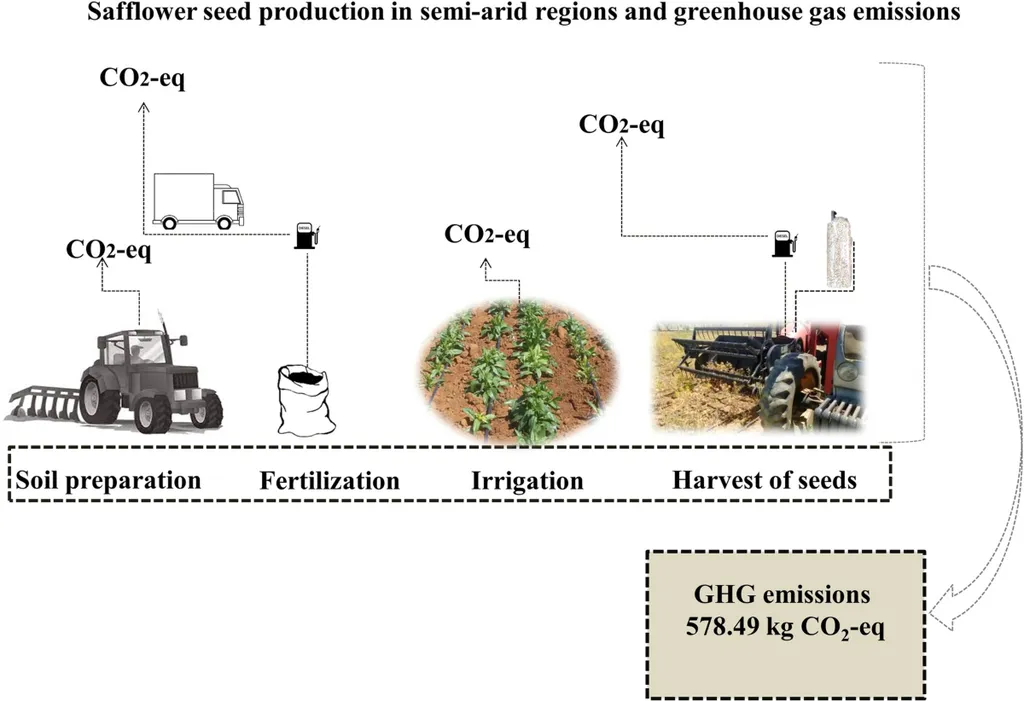In the heart of Iran’s semi-arid region, a groundbreaking study led by Ameneh Karizi from the Water Engineering Department at Shiraz University is reshaping our understanding of sustainable agriculture and water management. The research, published in the journal ‘Agricultural Water Management’ (which translates to ‘Water Management in Agriculture’), focuses on safflower, a drought-tolerant crop with significant potential for the energy sector, particularly in biofuel production.
The study evaluated various irrigation strategies and drip irrigation systems to optimize water use, crop productivity, and yield. Karizi and her team implemented three irrigation strategies: full irrigation (FI), partial root-zone drying (PRD) at 70% of FI, and conventional deficit irrigation (DI) at 70% of FI. They also examined three lateral spacings (20 cm, 40 cm, and 60 cm) and two drip irrigation systems—surface drip (SD) and subsurface drip (SSD).
The findings are promising. “Full irrigation with 20 cm spacing achieved the highest seed yield,” Karizi explains. However, the real game-changer lies in the water-saving strategies. PRD and DI saved 25% of irrigation water, with mean seed yield reductions of only 9.4% and 13.6%, respectively, compared to full irrigation. This balance between water conservation and yield is crucial for sustainable agriculture, especially in water-scarce regions.
The study also revealed that increasing lateral spacing reduced yield, with 60 cm spacing leading to a significant 24.3% decrease. Root growth was positively correlated with seed yield, with higher root length density (RLD) and root mass density (RMD) observed where soil water content was greater. This underscores the importance of optimal water distribution for root development and overall crop health.
One of the most compelling findings was the enhanced specific root length (SRL) under water-saving treatments. “Subsurface drip irrigation improved crop water productivity compared to surface drip,” Karizi notes. This is a significant insight for the energy sector, where safflower is increasingly being cultivated for biofuel production. Efficient water use and higher yields can make safflower a more viable and sustainable option for biofuel feedstock.
The study’s yield response factor (Ky) and yield sensitivity index (λi) analyses indicated that 20 cm lateral spacing enhanced drought tolerance. This is a critical factor for farmers and energy companies operating in arid and semi-arid regions, where water scarcity is a constant challenge.
So, what does this mean for the future of agriculture and the energy sector? The research suggests that subsurface drip irrigation with 40 cm spacing under PRD at 70% of full irrigation is an effective alternative for water-scarce regions. This approach balances water savings with minimal yield loss, making it a viable strategy for sustainable agriculture and biofuel production.
As the world grapples with climate change and water scarcity, such innovative approaches are more important than ever. Karizi’s research offers a beacon of hope, demonstrating that with the right strategies and technologies, we can achieve sustainable agriculture and secure the future of the energy sector. The findings published in ‘Agricultural Water Management’ are a testament to the power of scientific research in driving positive change and shaping a more sustainable future.

